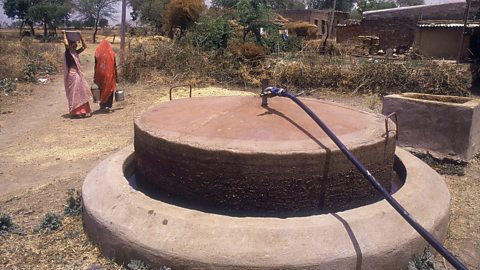Development and aid - a help or a hindrance?
International aid can help speed up development in low income developing country (LIDC)Any country that is among the poorest in the world, based on per capita income.. This can be categorised in a number of different ways.
Long-term and short-term aid
Long-term aid tries to solve a problem so that it never happens again, such as the construction of a dam to provide a clean water supply.
Short-term aid solves an immediate problem like providing shelter for victims after an earthquake. It is sometimes called 'crisis aid'.
Aid that lasts into the future is sometimes known as 'sustainable aid'.
Bilateral and multilateral aid
The prefix 'bi' means 'two', so bilateral aid is an arrangement between two countries. For example, the UK provides an aid package to Uganda. Sometimes, bilateral aid is described as 'tied aid', meaning the donor country expects something back from the recipient. This may be an agreement to sell it some particular goods, or to buy certain things from the donor. Trade and aid are often tied together.
The prefix 'multi' means 'many', so multilateral aid occurs when a group of countries get together to provide aid for a place. This might be a group like the United Nations, or the European Union, which has an aid programme funded by its member countries.
Government and charity aid
Government aid is funded by taxes paid to central government, while charity (or non-government) aid is funded by voluntary contributions from the public. Charity groups are sometimes referred to as non-governmental organisation (NGO)A company that does not work for the government, eg a charity.. Examples are groups like Oxfam, Save the Children, Comic Relief and Shelterbox.
Intermediate technology and large scale aid
Intermediate means 'in the middle', so intermediate technology is an improvement on existing simple technology, but not always using the most up-to-date technology available.
An example of intermediate technology used in India is the Gobar gas plants. These are brick-lined wells (or mobile tankers in more modern versions) to store animal manure which rots down to produce methane gas. This is piped to village homes to supply free and efficient energy for heating water and cooking.
Before the plants, villagers needed to invest a lot of time and energy collecting firewood for an open fire. The most advanced form of energy source in this situation would be a power station burning fossil fuels or a nuclear reactor producing electricity. However, this is not appropriate for rural India.

Many of these intermediate or "appropriate" technology projects are small-scale, and do not need huge amounts of money.
Another form of aid is large-scale aid (which is usually funded by governments) which involves major construction projects like river dams built with millions of pounds of cash investment.
Does aid help or hinder development?
Some aid, such as money or resources, can speed up development of a country by improving quality of life for the people that live there. However, aid does not always reach the countries most in need and some countries have corrupt governments that siphon off aid cash to fund their own luxuries or political events. In these cases, a lot of it never actually gets to the people it was originally intended to help.
Some international aid is not sustainable, in the sense that it damages the environment in a particular country. An example of this might be a large-scale mining operation with no programme to restore the area after extraction, or a project that builds large shallow wells in an area of low rainfall. This will use up water faster than it is replaced and will reduce water supplies for future generations. In contrast to this, a sustainable aid project might help switch people away from earning money from deforestation to making a living in a more sustainable way. This would ensure that forests will still be there for future generations to use.